Importance of Bathroom Mirrors
Bathroom mirrors play a crucial role in both the functionality and aesthetics of any bathroom. They are not just for checking your reflection but also enhance the overall design and feel of the space. A well-chosen mirror can make a bathroom feel brighter and more spacious by reflecting light and creating the illusion of depth. Mirrors also contribute to the daily routine, making activities like shaving, applying makeup, or styling hair more convenient and effective. Beyond their practical use, mirrors can act as a focal point in the bathroom, adding a touch of elegance or modernity to the décor.
Purpose of the Post
This post is designed to guide you through the process of selecting the perfect bathroom mirror. With so many options available, choosing the right mirror can seem overwhelming. Whether you are looking for a mirror that fits seamlessly into a traditional design, something sleek and modern, or a unique statement piece, understanding the different types, styles, and materials will help you make an informed decision. We’ll cover the various aspects you should consider, from the size and shape of the mirror to its placement and maintenance. The goal is to help you find a mirror that not only serves your functional needs but also enhances the beauty and ambiance of your bathroom. By the end of this post, you’ll have the knowledge and confidence to choose a mirror that perfectly complements your bathroom’s style and meets your personal needs.
Types of Bathroom Mirrors
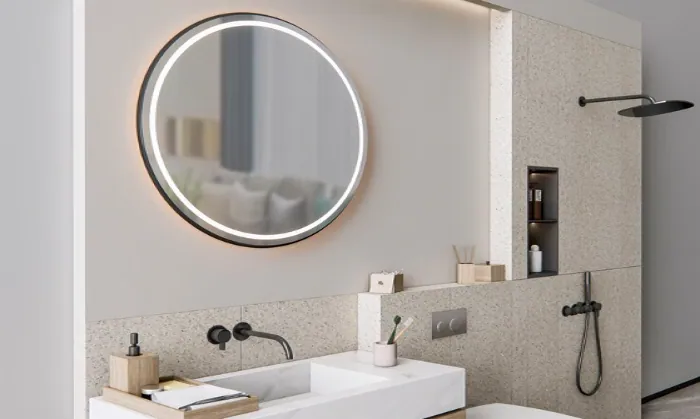
Framed vs. Frameless Mirrors
One of the first decisions to make when choosing a bathroom mirror is whether to go with a framed or frameless design. Framed mirrors offer a more traditional look and can add a decorative element to your bathroom. The frame itself can be made from various materials like wood, metal, or plastic, and can range from simple to ornate. Framed mirrors can help tie together the design elements of your bathroom, especially if the frame matches other fixtures or furniture. On the other hand, frameless mirrors provide a sleek, modern look. They are typically simpler, with clean lines and no distractions, making them a great choice for minimalist or contemporary bathrooms. Frameless mirrors also tend to make the space feel more open and are easier to clean due to the absence of a frame.
Round Mirrors
Round mirrors are increasingly popular in modern bathroom designs. Their soft, curved shape adds a touch of elegance and can make a bathroom feel more inviting. Round mirrors work well in small spaces because they break up the linearity of other elements like tiles, countertops, and cabinets. They’re also versatile, fitting in both modern and traditional settings. Whether above a vanity or as a statement piece, a round mirror can add balance and softness to the overall design.
Rectangular Mirrors
Rectangular mirrors are a classic choice and offer great versatility. They can be mounted vertically or horizontally, depending on the space and desired look. Rectangular mirrors are ideal for creating a balanced and symmetrical appearance, especially in larger bathrooms. They complement various design styles, from traditional to contemporary, and their straight lines can enhance the feeling of order and structure in the room.
Lighted Mirrors
Lighted mirrors come with built-in lighting, which adds both functionality and ambiance to your bathroom. These mirrors are especially useful in bathrooms with limited natural light, as they provide even illumination, reducing shadows while grooming or applying makeup. The lighting can be warm or cool, depending on your preference, and some lighted mirrors even offer dimmable settings. Beyond their practicality, lighted mirrors can create a luxurious spa-like atmosphere, making your bathroom feel more modern and upscale.
Material Options
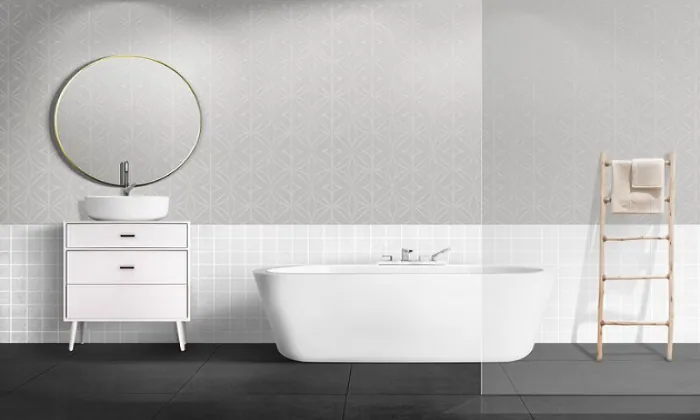
Glass Quality
When selecting a bathroom mirror, the quality of the glass is a crucial consideration. High-quality glass ensures that your mirror provides clear, distortion-free reflections, which is essential for tasks like grooming and makeup application. Lower-quality glass may have imperfections that cause distortions or cloudy reflections, diminishing both the functionality and aesthetic appeal of your mirror. In addition to clarity, durability is another important factor. High-quality mirrors often feature tempered glass, which is more resistant to breakage and safer for bathroom environments. Investing in a mirror with excellent glass quality ensures that it remains a reliable and attractive feature in your bathroom for years to come.
Frame Materials
The material of the mirror’s frame plays a significant role in both its style and durability. Wooden frames are a popular choice for those looking to add warmth and natural beauty to their bathroom. Wood frames can range from rustic to refined, depending on the finish and design. They are sturdy and long-lasting but may require some maintenance, especially in humid bathroom environments. Metal frames offer a sleek and modern look, perfect for contemporary or industrial-style bathrooms. Metals like stainless steel, aluminum, and brass are not only stylish but also highly durable and resistant to moisture, making them ideal for bathrooms. However, metal frames may require occasional polishing to maintain their shine. Plastic frames are a more affordable and versatile option. They come in a variety of colors and styles, making it easy to find a design that complements your bathroom decor. While plastic frames are lightweight and resistant to moisture, they may not offer the same level of durability as wood or metal.
Choosing the right frame material depends on your bathroom’s style, the level of maintenance you’re comfortable with, and your budget. Whether you prefer the warmth of wood, the sleekness of metal, or the versatility of plastic, the frame material will significantly influence the overall look and longevity of your bathroom mirror.
Design and Style Considerations
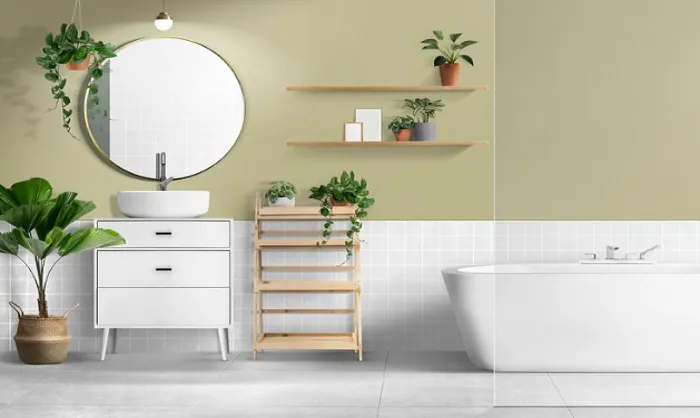
Traditional Designs
Traditional bathroom mirrors are known for their classic frames and ornate details that add a touch of timeless elegance to any space. These mirrors often feature intricately carved wooden frames, rich finishes, and decorative accents that evoke a sense of history and sophistication. Traditional designs are ideal for bathrooms with a more formal or vintage-inspired decor. They create a warm, inviting atmosphere and serve as a focal point in the room, drawing attention with their detailed craftsmanship. If your bathroom has elements like antique fixtures or classic tile patterns, a traditional mirror can seamlessly complement the overall design.
Modern Designs
For those who prefer a more contemporary look, modern mirrors offer sleek and minimalistic options that fit perfectly in modern spaces. These mirrors often have clean lines, frameless designs, and geometric shapes, emphasizing simplicity and function. A modern bathroom mirror can enhance the sense of space and light in a room, making it feel more open and airy. They are often paired with modern vanities and fixtures to create a cohesive, streamlined look. If your bathroom features minimalistic decor, neutral colors, and modern lighting, a modern mirror is the perfect choice to complete the aesthetic.
Rustic Designs
Rustic mirrors bring the charm of nature into your bathroom with their natural textures and earthy tones. These mirrors often feature frames made from reclaimed wood, distressed finishes, or materials like stone and metal that add a rugged, organic feel. Rustic designs are perfect for creating a cozy, warm atmosphere in bathrooms that embrace a country, farmhouse, or cottage style. If your bathroom includes elements like exposed beams, natural stone, or earthy color palettes, a rustic mirror will enhance the room’s character and charm.
Transitional Designs
For those who appreciate a blend of old and new, transitional mirrors combine traditional and modern elements to create a balanced, versatile style. These mirrors might feature a classic frame with a modern finish or a contemporary shape with subtle traditional detailing. Transitional designs are ideal for those who want the best of both worlds—a mirror that is stylish yet timeless, sophisticated yet approachable. If your bathroom decor mixes different styles or if you’re looking for a versatile piece that can adapt to various design changes over time, a transitional mirror is an excellent choice.
Size and Placement Considerations
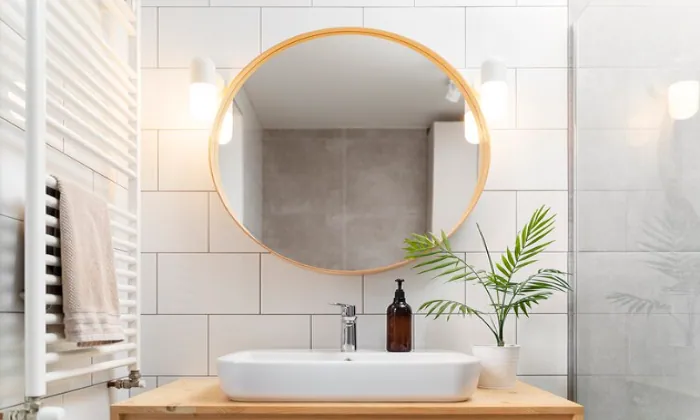
Choosing the Right Size
Selecting the right size mirror for your bathroom is essential for both aesthetics and functionality. The mirror should be proportional to the size of the vanity and the overall bathroom space. If the mirror is too small, it might not provide adequate reflection or visual impact. Conversely, a mirror that is too large can overwhelm the space and make it feel crowded. A good rule of thumb is to choose a mirror that is slightly narrower than your vanity. This creates a balanced look and ensures that the mirror complements the sink area. For larger bathrooms, consider using a larger mirror or even multiple mirrors to enhance the sense of space and light.
Optimal Placement
The placement of your bathroom mirror plays a crucial role in its functionality and visual appeal. Typically, the mirror is placed above the vanity, centered with the sink, to provide a convenient reflection for daily tasks like grooming and makeup application. The height at which you hang the mirror is also important; it should be at a comfortable eye level for most users. A general guideline is to hang the mirror so that the center is approximately 57 to 65 inches from the floor, depending on the average height of the people using the bathroom.
In addition to the standard above-vanity placement, consider the overall lighting in the room. Placing the mirror in a location where it can reflect natural light from a window can brighten the space and make the bathroom feel larger. If your bathroom has limited light, consider using a mirror with built-in lighting or placing wall sconces on either side of the mirror to ensure even illumination.
For a more creative approach, you might also place mirrors on other walls to reflect decorative elements or to create the illusion of more space. Careful consideration of size and placement will ensure that your bathroom mirror enhances both the functionality and style of your space.
Budget Considerations
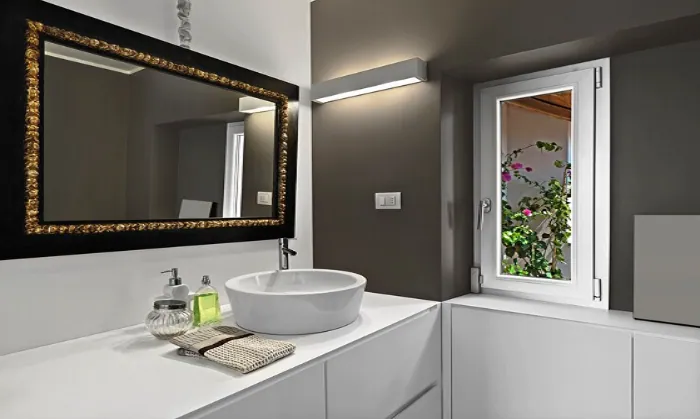
Setting a Budget
When selecting a bathroom mirror, it's essential to set a budget that balances cost, quality, and style. Mirrors can range widely in price depending on factors like size, material, and brand. Before shopping, determine how much you're willing to spend, considering both your financial constraints and the overall value the mirror will add to your bathroom. It’s helpful to look at the mirror as an investment, not just a decorative piece. While it might be tempting to go for the cheapest option, a lower-quality mirror may not last as long or provide the same level of style and function as a more thoughtfully chosen one. Setting a budget helps you narrow down your options and focus on mirrors that meet your quality standards without overspending.
Cost vs. Value
When considering cost, it's important to think about the value the mirror will bring to your bathroom over time. A well-made, stylish mirror can significantly enhance the overall appearance of your bathroom, making it look more polished and inviting. Additionally, higher-quality mirrors often offer better durability, meaning they will maintain their clarity and appearance for years. This makes them a worthwhile investment compared to cheaper options that may need to be replaced sooner.
For example, mirrors with high-quality glass and sturdy frames may cost more upfront, but they offer better reflective quality and longevity. Similarly, mirrors with additional features, such as built-in lighting or anti-fog technology, might have a higher price tag but can add significant value in terms of convenience and aesthetic appeal.
Ultimately, when balancing cost and value, consider how the mirror will contribute to both the functionality and style of your bathroom. Investing in a mirror that fits your needs and complements your design can provide long-term satisfaction and make your bathroom a more enjoyable space.
Maintenance Tips
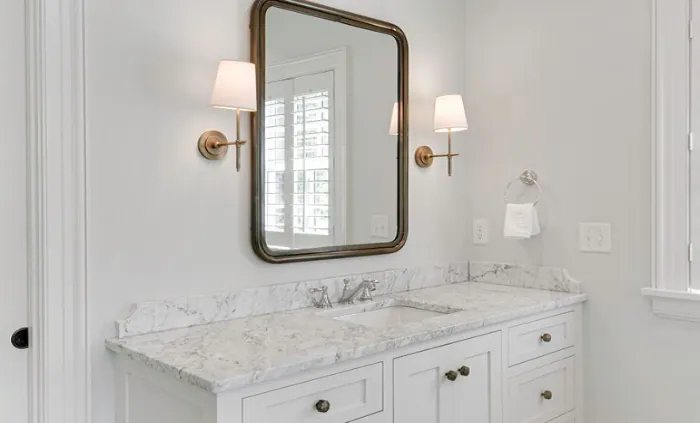
Routine Cleaning
Keeping your bathroom mirror spotless and streak-free is essential for both functionality and appearance. Regular cleaning prevents the build-up of grime, water spots, and streaks, which can diminish the clarity of the reflection. To clean your mirror effectively, use a soft, lint-free cloth or microfiber towel. Avoid paper towels, as they can leave behind fibers that cause streaks.
Begin by spraying a small amount of glass cleaner directly onto the cloth, not the mirror, to avoid excessive moisture, which can seep into the edges of the mirror and cause damage over time. Gently wipe the mirror in a circular motion or from top to bottom to ensure even coverage. For tough spots or fingerprints, apply a bit more pressure, but avoid scrubbing too hard, as this can damage the surface. For a natural cleaning solution, you can mix equal parts water and white vinegar, which works well for removing streaks and leaves the mirror sparkling.
Frame Care
The care of your mirror’s frame depends largely on the material it is made from. Each material requires specific maintenance to keep it looking its best and prolong its life.
- Wood Frames: Wood frames add warmth and character to a mirror but need regular dusting and occasional polishing. Use a dry, soft cloth to remove dust and a wood cleaner or polish to keep the wood looking rich and smooth. Avoid using water or harsh chemicals, as they can damage the finish and cause the wood to warp over time.
- Metal Frames: Metal frames, such as those made from stainless steel, aluminum, or brass, are durable but can tarnish or rust if not cared for properly. Wipe metal frames with a damp cloth to remove fingerprints and dust. For polished or shiny metal, use a specific metal cleaner or a mixture of mild soap and water. Be sure to dry the frame thoroughly to prevent water spots or rust.
- Plastic Frames: Plastic frames are easy to care for and generally require only regular dusting and an occasional wipe-down with a damp cloth. Avoid abrasive cleaners that can scratch the plastic surface.
By following these maintenance tips, you can keep your bathroom mirror looking pristine and ensure that it remains a stylish and functional part of your bathroom for years to come.
Choosing the right bathroom mirror involves considering key factors like size, style, material, and placement. A well-selected mirror not only enhances the functionality of your bathroom but also adds to its overall aesthetic appeal. Whether you prefer a traditional, modern, rustic, or transitional design, there are countless options to explore. Take the time to find a mirror that suits your space, complements your decor, and meets your needs. With the right mirror, you can elevate both the look and feel of your bathroom, making it a more enjoyable and stylish space.

Comments